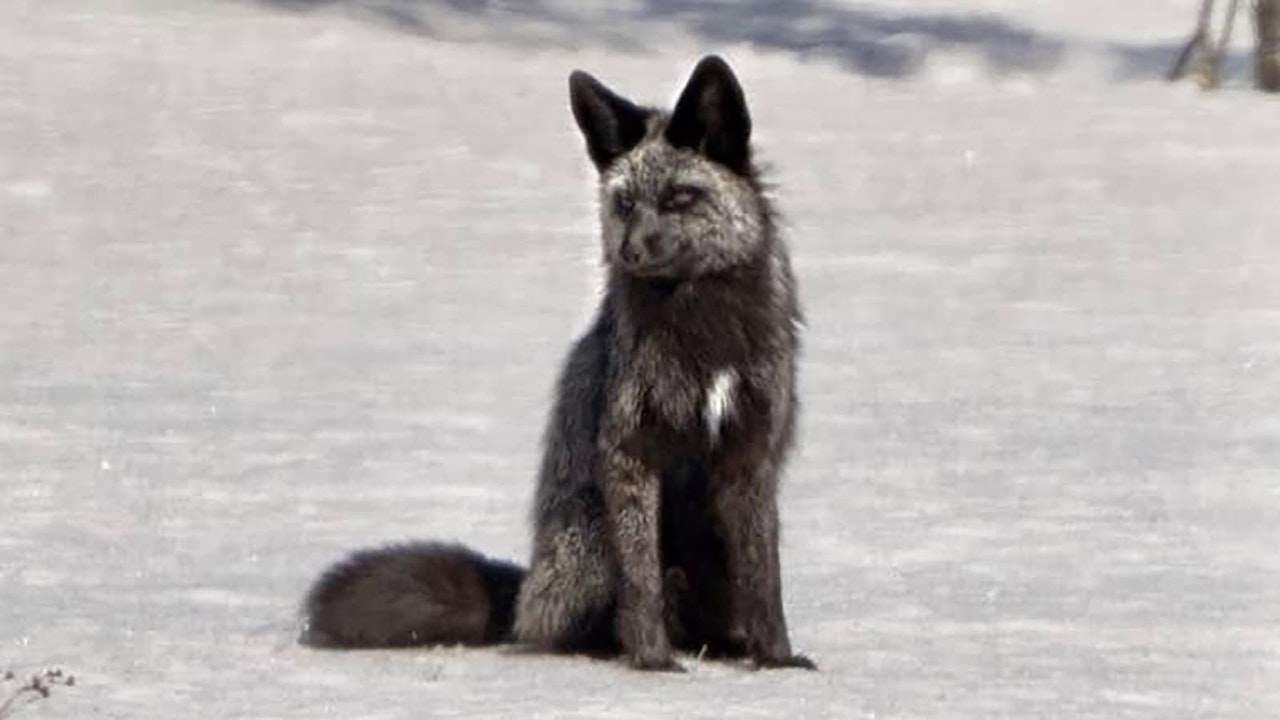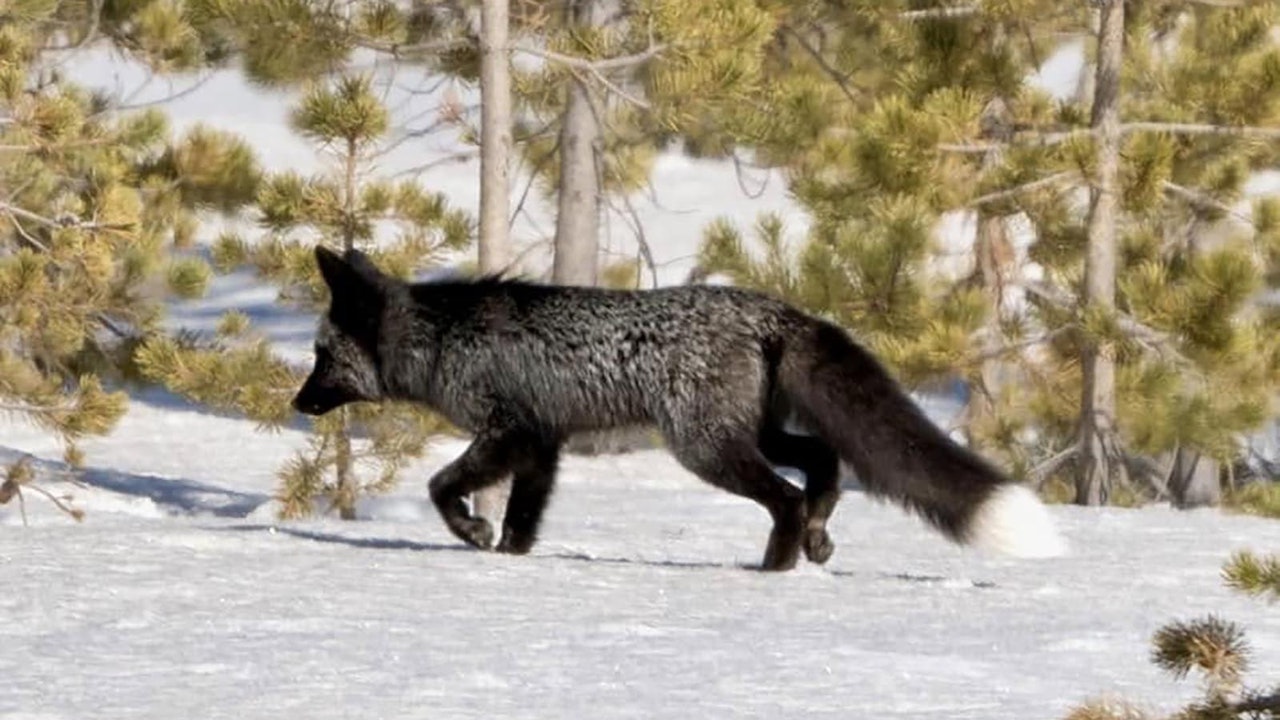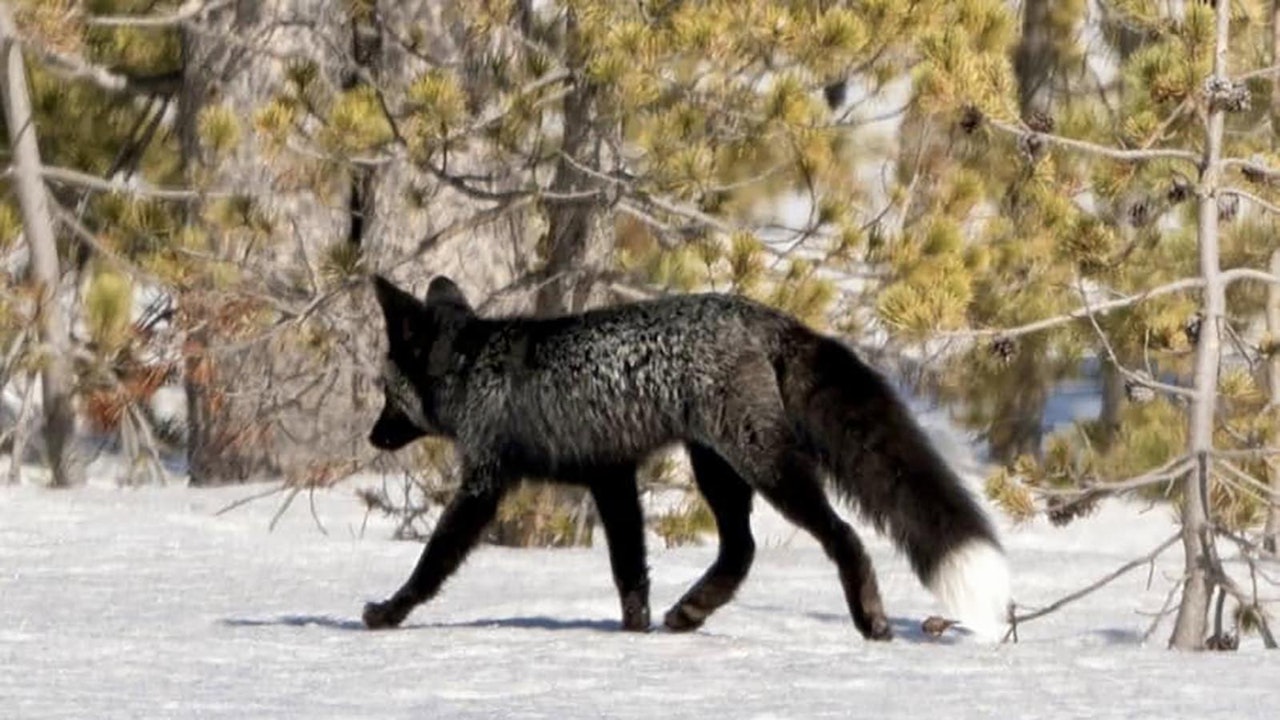
Posted on 04/23/2025 8:24:05 PM PDT by Red Badger
A fox with rare black fur made a brief roadside appearance in Yellowstone National Park last week. The fox’s coloring is probably the result of a condition called melanism.

Stacy O’Nell caught photos of this extremely rare black fox in Yellowstone National Park, when it made a brief appearance along the roadside last week. The fox’s unusual coloring is probably the result of a condition called melanism, which can cause black skin, fur or feathers in numerous species. (Courtesy Stacy O'Nell, SO Photograpy) Now in her third season of working at the Yellowstone National Park’s Old Faithful Inn, Stacy O’Nell thought she’d seen just about every kind of critter in the park.
But while driving near Old Faithful last week, she noticed a bicyclist had stopped to gawk at something near the roadside. So she slowed down to take a look for herself, and couldn’t believe what she saw.
A black fox, with smatterings of white and silver in its fur, was hanging out in plain sight.
“I didn’t think they (black foxes) really existed,” she told Cowboy State Daily. “And now everyone is talking about him.”
O’Nell is also a wildlife photographer, and the fox stuck around long enough for her to get a few pictures of it, before it dashed back into the timber and out of sight.
Other than its odd coloring, the fox appeared to be alert and healthy, O’Nell said. She did some checking and discovered the little canine’s coloring was probably because of a condition called melanism.
In simple terms, melanism is essentially the opposite of albinism – which can cause some animals and birds to have rare white skin, fur or feathers.
Other than turning animals unusually dark, or even full black, melanism isn’t considered to be a harmful condition. It occurs in several species, some of which include barn owls and deer.
Melanistic animals aren’t to be confused with species that are naturally dark, such as black panthers.

Stacy O’Nell caught photos of this extremely rare black fox in Yellowstone National Park, when it made a brief appearance along the roadside last week. The fox’s unusual coloring is probably the result of a condition called melanism, which can cause black skin, fur or feathers in numerous species. (Courtesy Stacy O'Nell, SO Photograpy) Fox Color Varies By Elevation Wildlife researcher Gary Beauvais agreed that melanism is probably the best explanation for the fox near Old Faithful looking the way that it does.
“Yes, the black phase of the red fox (Vulpes vulpes) is considered an example of melanism. The red fox is known to exhibit several color phases, including black, silver, and ‘cross,’” he told Cowboy State Daily.
Red foxes in Wyoming are usually the classic red color when they live in the low country, added Beauvais, who is the director of the Wyoming Natural Diversity Database at the University of Wyoming.
“In the low elevations of Wyoming, the typical coloring is the classic orange body, dark legs and white-tipped tail. All color phases have the white-tipped tail. It is a good field characteristic and allows positive identification, versus coyotes in brief and/ or distant sightings,” he said.
“At higher elevations most individuals have a noticeable grayish cast on the body, and there is some information suggesting that red foxes at high elevations in western North America form a distinct subspecies,” he added.
Fur Farm Escapees? Dark-colored foxes have made a few appearances over the years, Beauvais said.
“In the 1990s, a pair of dark – possibly black, possibly silver-phase – red foxes were repeatedly sighted and reported near Chimney Park (in the Jelm, Wyoming, area),” he said.
And several years ago, a “full-black phase” female fox raised a litter of kits in her den near the Wyoming Game and Fish office in Laramie – much to the delight of local photographers, Beauvais said.
There’s also speculation that “off-color” phases in foxes have become more common recently, he said.
That could be because of foxes that escaped or released from fur farms, years ago, he said.
“Apparently fur farms, in which specially colored furbearers were deliberately bred and raised, were more common in the region in the past. Some animals occasionally escaped, and some people speculate that when some farms failed as businesses, they released remaining animals into the wild, increasing the frequency of off-color genes in local populations,” Beauvais said.
“It would be an interesting thing to research and confirm or refute,” he added.
‘He’s Caused A Stir’ O’Nell said that ever since her encounter with the dark fox, she’s been keeping her eyes peeled for the unusual animal.
“I circled back around a couple of times (to the spot where she saw the fox) and he wasn’t there,” she said.
“I’m going to keep looking for him. He’s caused a stir around here,” she added.
Contact Mark Heinz at mark@cowboystatedaily.com

Stacy O’Nell caught photos of this extremely rare black fox in Yellowstone National Park, when it made a brief appearance along the roadside last week. The fox’s unusual coloring is probably the result of a condition called melanism, which can cause black skin, fur or feathers in numerous species. (Courtesy Stacy O'Nell, SO Photograpy)
Not so much. One ran up the bottom of my dad’s property.
“It’s a sign!”
Of what? .......................
Saw a black squirrel and a piebald nubbin buck on the same day once. Oct 06. Nothing happened.
Some American Indian tribes used to say the sighting of a White California was a sign of good luck. Maybe the same could be said about another uncommon sight: that of the “illusive” Black Fox. Time will tell.
California = ,Calf.
Auto correct tried to fix it for me.
He’s beautiful. I love foxes. I saw a documentary a while back about some scientists who were breeding foxes for domestication. They had an entire barn of foxes and would only breed the ones who tolerated handling and human interaction. One of the results of the breeding stock were color changes. The friendliest foxes would have beautiful displays of white on their chests or sides, with fluffy black tails.
Had an all black coyote last year outside the house, very healthy and a beautiful animal. Saw it twice in one week.
Head to Yellowstone in a couple weeks for a week... getting there before main group of tourons arrive.
FROM BRAVE AI:
Soviet Fox Experiment
The Soviet fox experiment, also known as the Russian Farm-Fox Experiment, was initiated by Soviet scientist Dmitry Belyaev in the 1950s. The goal was to recreate the evolution of gray wolves into domesticated dogs, but in a much shorter timeframe using silver foxes.
Belyaev and his team selected foxes that showed the most curiosity and least aggression towards humans, breeding only the friendliest pups in each generation.
This selective breeding process resulted in foxes that were more tame and exhibited behaviors similar to domesticated dogs, such as wagging their tails when seeing people.
By 1996, after about 40 years and 45,000 foxes, the experimenters had a population of 100 foxes, the product of 30 to 35 generations of selection.
These foxes were notably more friendly and less aggressive compared to their wild ancestors.
However, the collapse of the Soviet Union led to funding issues, making it difficult to continue the research.
The experiment has been pivotal in understanding the genetic and behavioral changes associated with domestication. In a study published in 2018, scientists used genome sequencing to identify 103 stretches of the fox genome that appeared to have been altered by the breeding process, potentially revealing genes responsible for social behavior.
Some researchers have questioned the significance of the domestication syndrome in the fox experiment, suggesting that the conclusions drawn from it may have been overstated.
Nonetheless, the experiment remains a significant case study in the field of animal domestication.
In recent years, the domesticated foxes have been trained for various tasks, including scent detection for search and rescue operations.
https://www.youtube.com/watch?v=IXgVW0ng2CA
😯........................
Makes you wonder! Black Panthers are melanistic variations of Leapords and also jaguars. Bad example
Lol!

The Black Fox.
What does the fox say?
Last seen eating watermelon and some fried chicken. /sarc
Disclaimer: Opinions posted on Free Republic are those of the individual posters and do not necessarily represent the opinion of Free Republic or its management. All materials posted herein are protected by copyright law and the exemption for fair use of copyrighted works.